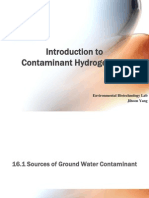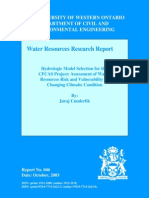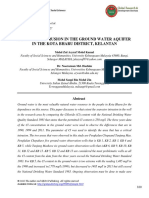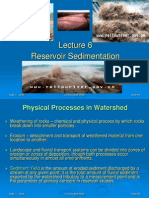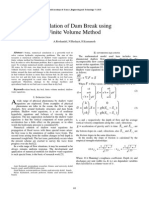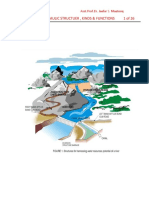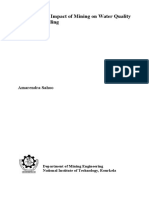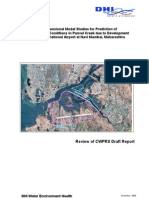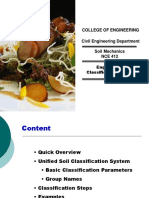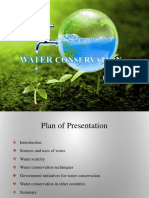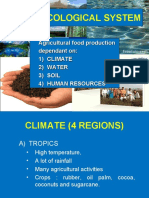0 ratings0% found this document useful (0 votes)
230 viewsGuidelines For Modelling Groundwater-Surface Water Interaction in Ewater Source
Guidelines For Modelling Groundwater-Surface Water Interaction in Ewater Source
Uploaded by
eWaterOne of the key challenges in modelling GW-SW interactions is the significant time-scale
differences between surface water and groundwater processes. Because groundwater movement can be orders of magnitude slower than surface water movement, the responses of groundwater systems to hydrological and management drivers such as climate variability, land use change, and groundwater extraction can be very damped and lagged. Hence, a key requirement in modelling GW-SW interactions in river system models is to account for these time lags.
The modelling of GW-SW interactions in river system models is still very much in its
infancy, not just in Australia, but also throughout the world. As such, there is no consensus on implementation of this functionality in river system models, and hence the little discussion in the literature so far on what constitutes Best Practice Modelling in this domain.
Copyright:
© All Rights Reserved
Available Formats
Download as PDF, TXT or read online from Scribd
Guidelines For Modelling Groundwater-Surface Water Interaction in Ewater Source
Guidelines For Modelling Groundwater-Surface Water Interaction in Ewater Source
Uploaded by
eWater0 ratings0% found this document useful (0 votes)
230 views25 pagesOne of the key challenges in modelling GW-SW interactions is the significant time-scale
differences between surface water and groundwater processes. Because groundwater movement can be orders of magnitude slower than surface water movement, the responses of groundwater systems to hydrological and management drivers such as climate variability, land use change, and groundwater extraction can be very damped and lagged. Hence, a key requirement in modelling GW-SW interactions in river system models is to account for these time lags.
The modelling of GW-SW interactions in river system models is still very much in its
infancy, not just in Australia, but also throughout the world. As such, there is no consensus on implementation of this functionality in river system models, and hence the little discussion in the literature so far on what constitutes Best Practice Modelling in this domain.
Original Title
Guidelines for Modelling Groundwater-Surface Water Interaction in eWater Source
Copyright
© © All Rights Reserved
Available Formats
PDF, TXT or read online from Scribd
Share this document
Did you find this document useful?
Is this content inappropriate?
One of the key challenges in modelling GW-SW interactions is the significant time-scale
differences between surface water and groundwater processes. Because groundwater movement can be orders of magnitude slower than surface water movement, the responses of groundwater systems to hydrological and management drivers such as climate variability, land use change, and groundwater extraction can be very damped and lagged. Hence, a key requirement in modelling GW-SW interactions in river system models is to account for these time lags.
The modelling of GW-SW interactions in river system models is still very much in its
infancy, not just in Australia, but also throughout the world. As such, there is no consensus on implementation of this functionality in river system models, and hence the little discussion in the literature so far on what constitutes Best Practice Modelling in this domain.
Copyright:
© All Rights Reserved
Available Formats
Download as PDF, TXT or read online from Scribd
Download as pdf or txt
0 ratings0% found this document useful (0 votes)
230 views25 pagesGuidelines For Modelling Groundwater-Surface Water Interaction in Ewater Source
Guidelines For Modelling Groundwater-Surface Water Interaction in Ewater Source
Uploaded by
eWaterOne of the key challenges in modelling GW-SW interactions is the significant time-scale
differences between surface water and groundwater processes. Because groundwater movement can be orders of magnitude slower than surface water movement, the responses of groundwater systems to hydrological and management drivers such as climate variability, land use change, and groundwater extraction can be very damped and lagged. Hence, a key requirement in modelling GW-SW interactions in river system models is to account for these time lags.
The modelling of GW-SW interactions in river system models is still very much in its
infancy, not just in Australia, but also throughout the world. As such, there is no consensus on implementation of this functionality in river system models, and hence the little discussion in the literature so far on what constitutes Best Practice Modelling in this domain.
Copyright:
© All Rights Reserved
Available Formats
Download as PDF, TXT or read online from Scribd
Download as pdf or txt
You are on page 1of 25
eWater Cooperative Research Centre
eWater Limited ABN 47 115 422 903
Innovation Centre, Building 22
University Drive South
Bruce ACT 2617
Phone: +61 2 6201 5168
contact@ewater.com.au
www.ewater.com.au
Guidelines for Modelling Groundwater-
Surface Water Interactions in eWater Source:
Towards Best Practice Model Application
November 2011
David Rassam, Ian J olly, Trevor Pickett
Interim Version 1.0
Best Practice Model Application Guidelines for eWater Source
Page 1
Copyright Notice
eWater Ltd 2011
Legal Information
This work is copyright. You are permitted to copy and reproduce the information, in an
unaltered form, for non-commercial use, provided you acknowledge the source as per the
citation guide below. You must not use the information for any other purpose or in any other
manner unless you have obtained the prior written consent of eWater Ltd.
While every precaution has been taken in the preparation of this document, the publisher and
the authors assume no responsibility for errors or omissions, or for damages resulting from
the use of information contained in this document. In no event shall the publisher and the
author be liable for any loss of profit or any other commercial damage caused or alleged to
have been caused directly or indirectly by this document.
Citing this document
Rassam, D.W., J olly, I., and Pickett, T. (eWater Cooperative Research Centre 2011)
Guidelines for Modelling Groundwater-Surface Water Interactions in eWater Source: Towards
Best Practice Model Application.
Publication date: November 2011 (Interim Version 1.0)
ISBN 978-1-921543-59-3
Acknowledgments
eWater CRC acknowledges and thanks all partners to the CRC and individuals who have
contributed to the research and development of this publication.
We acknowledge inputs from the following: steering committee members, Michael Williams,
Chris Ribbons, Rick Evans, and Carl Daamen; eWater Source Rivers Project, Matt Bethune,
Geoff Podger, Wendy Welsh, and Dugald Black; Namoi trial team, Craig McNeilage, Hemal
J ayawickrama, Shahadat Chowdhury, and Linda Holz.
eWater CRC gratefully acknowledges the Australian Governments financial contribution to
this project through its agencies, the Department of Innovation, Industry, Science and
Research, the Department of Sustainability, Environment, Water, Population and
Communities and the National Water Commission
For more information:
Innovation Centre, Building 22
University Drive South
Bruce, ACT, 2617, Australia
T: 1300 5 WATER (1300 592 937)
T: +61 2 6201 5834 (outside Australia)
E: contact@ewater.com.au
www.ewater.com.au
Groundwater-Surface Water Interactions
Page 2
Table of Contents
1 Introduction 3
1.1 Background 3
1.2 Scope 3
2 Procedure For Quality Assured Application 5
2.1 Project administration 5
2.2 Problem definition 6
2.2.1 Problem statement 6
2.2.2 Metrics & criteria 7
2.2.3 Uncertainty and risk 7
2.3 Option modelling 7
2.3.1 Methodology development 8
2.3.2 Calibrate model 14
2.3.3 Sensitivity/uncertainty analysis 17
2.4 Identify preferred option 17
2.4.1 Techniques for selecting the best option 18
2.4.2 Performance Criteria 18
2.4.3 Finding the best option 18
2.4.4 Report/communicate comparison of options 18
3 Model choice 18
4 Further reading 19
5 Glossary 20
6 References 21
Best Practice Model Application Guidelines for eWater Source
Page 3
1 Introduction
1.1 Background
In many river systems, the extraction of large volumes of groundwater in close proximity to
major streams and rivers has the potential to reduce stream flows. Basin-scale prediction
tools that simulate these complex groundwater-surface water (GW-SW) interactions are
required to assist in providing sustainable allocation of water. In un-regulated upland
streams, the primary impacts are on low-flow conditions that are crucial to ecosystem
health. In regulated rivers, the primary impacts are on water security as the rivers interact
with the underlying groundwater system in a spatially and temporally varying manner. This
interaction can be a gain to the river or loss from the river; the latter is considered an
important source of recharge to the groundwater aquifer. In some situations there may be
instances where the same parcel of water is allocated to more than one water user (i.e.
double allocation).
The eWater CRC is developing the Source Integrated Modelling System (IMS), which is the
next generation of software tools for river planning, management and operation. As part of
this effort, the eWater/National Water Commission Groundwater Surface Water Interaction
Tool (GSWIT) project has developed modules that provide GW-SW interaction capability
for Source IMS (J olly et al., 2010).
One of the key challenges in modelling GW-SW interactions is the significant time-scale
differences between surface water and groundwater processes. Because groundwater
movement can be orders of magnitude slower than surface water movement, the
responses of groundwater systems to hydrological and management drivers such as
climate variability, land use change, and groundwater extraction can be very damped and
lagged. Hence, a key requirement in modelling GW-SW interactions in river system
models is to account for these time lags.
The modelling of GW-SW interactions in river system models is still very much in its
infancy, not just in Australia, but also throughout the world. As such, there is no consensus
on implementation of this functionality in river system models, and hence the little
discussion in the literature so far on what constitutes Best Practice Modelling in this
domain.
1.2 Scope
This document hereafter referred to as this guidance has been prepared by eWater as
a first attempt at providing guidance on the application of GW-SW interactions in existing
river and groundwater models, and in the new Source IMS modelling tools incorporating
GW-SW functionality. It is based on a combination of a literature review (Rassam and
Werner, 2008), lessons learnt from the recent Murray-Darling Basin Sustainable Yield
Groundwater-Surface Water Interactions
Page 4
(MDBSY) project (Rassam et al., 2008), and lessons learnt during the development of the
GW-SW functionality in Source IMS (Rassam, 2011) and testing this functionality in trial
reaches in the Namoi River basin.
The target audience for this document is practising river system and catchment modellers
with an appropriate background who are interested in incorporating GW-SW interactions in
their river planning models, i.e. it is not a text book.
This guidance is one of a series of Best Practice Modelling that has been prepared by
eWater for each of the major functionalities of Source IMS (Welsh et al., 2011). The
overarching Best Practice Modelling framework for this series of documents is eWaters
Guidelines for Water Management Modelling (Black et al., 2011). These propose a high
level generic procedure that is intended to result in quality assured model applications.
The overall decision framework in the generic guidelines is illustrated in Figure 1.
Figure 1: Decision framework for model application (Black et al., 2011)
The generic guidelines describe a procedure for quality assured model application which
can be summarised as comprising four phases:
1. Project management,
2. Problem definition,
3. Option modelling,
4. Compare options and select the best.
This guidance deals mainly with phases 2 and 3. From the point of view of application of
GW-SW interaction modelling in Source IMS the generic guidelines mostly provide
sufficient information relevant to phases 1 and 4, particularly as GW-SW interaction
modelling usually comprises part of a larger project and phases 1 and 4 would be covered
in more detail in the planning and undertaking of this larger project.
Best Practice Model Application Guidelines for eWater Source
Page 5
2 Procedure For Quality Assured
Application
The generic procedure proposed in Black et al. (2011) for quality assured model application
is adapted from Blackmore et al. (2009) and is summarised in Figure 2. Please note that
the procedure is flexible and should be tailored to the particular modelling project at hand.
For brevity, many sections in Chapter of this guidance simply refer the reader to the
equivalent sections of the generic guidelines in order to avoid repetition of material.
Figure 2: Flow chart of procedure for quality assured model application (adapted
from Blackmore et al., 2009)
2.1 Project administration
All the guidance on project administration in the generic guidelines applies to the
implementation of GW-SW interaction modelling in Source IMS, and no additional guidance
needs to be provided here.
Groundwater-Surface Water Interactions
Page 6
2.2 Problem definition
All the guidance on the Problem Definition phase in the generic guidelines is relevant to
modelling GW-SW interactions. Additional to this, guidance specific to modelling GW-SW
interactions is provided on the following topics in the sections below:
Problem statement,
Metrics and criteria, and
Uncertainty and risk.
In relation to GW-SW interactions specifically, it is implicitly assumed that the work is
concerned with implementing a catchment or river model where the river is in saturated
connection with an underlying groundwater system, and that groundwater exchange is
thought to be an important component of the river water balance. For the saturated
connection, a range of processes impact the GW-SW exchange flux such as bank storage,
groundwater extraction, evapotranspiration, and recharge. If the underlying groundwater is
too deep to be in saturated connection then the process is restricted to surface water loss
to the underlying aquifer (river recharge). The depth of the water table at which a river
system becomes disconnected from the underlying groundwater system can be
theoretically evaluated according to the criteria proposed by Brunner et al. (2009). Details
on the experimental methods for assessing the state of connection between rivers and
aquifers are found in Brownbill et al. (2011).
2.2.1 Problem statement
Extensive analyses should be conducted to justify the need for a new model to estimate the
GW-SW exchange fluxes. For example, if good quality groundwater head data is available
in close proximity to the river reach of interest, and the period and frequency of the
groundwater data record correspond to those of the river model calibration/prediction
period, then the fluxes can be calculated using Darcys Law (see Equation 2 of the
Groundwater chapter of the Source Rivers Scientific Reference Guide; eWater, 2010b).
Alternatively, a groundwater model that encompasses the reaches of interest might be
available. In such cases, the GW-SW exchange fluxes predicted by the groundwater model
can be imported into the river model. However, prior to this process, one needs to ensure
that the groundwater model satisfies some critical criteria. Firstly, the calibration period
and the time steps of the groundwater model need to correspond to those of the river
model. Secondly, the groundwater model has been purpose-built to provide reliable
predictions for GW-SW exchange fluxes; for example, one of the crucial requirements is a
suitable boundary condition such as the River boundary in MODFLOW. Note that due to
the dependence of the GW-SW exchange fluxes on the river stage height, it may be
necessary to calibrate the groundwater and river models simultaneously; this implicitly
means that this is an iterative process (see Section 2.3.4 below).
Best Practice Model Application Guidelines for eWater Source
Page 7
2.2.2 Metrics & criteria
Where model calibration is part of the scope of work, consideration should be given to how
good a model calibration needs to be, and which aspects of model performance are of
greatest interest; these should feature in calibration metrics. Middlemis (2000) and Hill and
Tiedeman (2007) discuss relevant calibration metrics for groundwater modelling. After
achieving a satisfactory calibration, one needs to assess the quality of the model
predictions and the associated uncertainty. Further guidance on this topic is available in the
subsection on metrics and criteria in the Problem Definition phase section, in Chapter 2 of
the generic guidelines.
2.2.3 Uncertainty and risk
Much of the subsection on uncertainty and risk in the Problem Definition phase section, in
Chapter 2 of the generic guidelines is in principle relevant to the implementation of GW-SW
interaction modelling in Source IMS. However, work on model uncertainty and decision
frameworks (e.g. CREM, 2008; Blackmore et al., 2009) has not been tested in the
groundwater domain. While Hill and Tiedeman (2007) have extensive discussion on
methodologies for assessing parameter and predictive uncertainty, the highly mathematical
nature of the subject has resulted in only minimal uptake of the techniques by groundwater
modellers in Australia. The more recent work by Doherty (2010) and Doherty et al. (2011)
provide a good insight on this topic.
Development of practical, easy to use, uncertainty and risk techniques for GW-SW
interaction modelling is clearly an area of future research, but is outside the scope of
eWater. CSIRO has recently commenced a study based in the Namoi River basin on
this research topic (see Lerat et al., 2011).
2.3 Option modelling
The guidance on option modelling in the generic guidelines is relevant to modelling GW-
SW interactions except the guidance on uncertainty analysis, which is only partly relevant
for reasons discussed in Section 2.2.3. Additional guidance specific to modelling GW-SW
interactions is provided on the following steps in the sections below:
Methodology development,
Calibrate model, and
Sensitivity/uncertainty analysis.
Groundwater-Surface Water Interactions
Page 8
2.3.1 Methodology development
A key requirement for modelling GW-SW exchange fluxes is accounting for the time lags
associated with groundwater processes that are much slower than those of surface water.
Moreover, the hydraulic connection between a river and the underlying aquifer (as informed
by connectivity mapping) can either be saturated or unsaturated depending on the location
of the water table relative to the river stage.
The GW-SW exchange flux comprises four components:
(1) natural exchange flux resulting from river stage fluctuations during low flow conditions,
within bank and overbank fluctuations;
(2) flux due to groundwater extraction;
(3) flux due to changes in aquifer recharge; and
(4) flux due to changes in evapotranspiration.
The sum of those components at any time dictates whether the river loses water to or gains
water from the aquifer. A detailed description of the processes that actively contribute to
the flux and that contribution varies with the type of river-aquifer connection is found in
Rassam (2011).
The GW-SW exchange flux can be determined using one of the following methods,
depending on data and model availability:
Head-Based Method: From knowledge of the head difference between the river stage and
the water table level in the underlying aquifer at any time, the GW-SW exchange flux can
be defined by multiplying the head difference by the hydraulic conductance of the river-
aquifer interconnection (see Equation 2 in the Groundwater section of the Source Rivers
Scientific Reference Guide; eWater, 2010b). The head difference at any time t captures
the state of connection between the river and the underlying aquifer and hence represents
a realisation of all the stresses in the aquifer up to that particular time T. The advantage of
this method is that the flux calculations can start and finish at any time thus coinciding with
the simulation (or calibration) period of the river model; this is conceptually correct because
of the transient nature of the data. However, the limitation of this method is that the
required data is unlikely to be available in many instances.
Flux-Based Method: Assuming that an initial starting condition can be identified at some
pre-development time T (i.e. when the direction and magnitude of the exchange flux was
known), one can then estimate subsequent fluxes directly from the stresses in the aquifer
(e.g. a pump) using the appropriate analytical or numerical solutions then add them to the
initial starting flux. The pre-development flux used should be a long-term average derived
during non-flood event periods that represent base-flow conditions. Depending on the
choice of T and how it relates to when the stresses had started (or will start), the full, or
partial impacts of those stresses are superimposed on the initial starting flux to obtain the
total exchange flux at any time (including extrapolation into the future). It is a pre-requisite
in this method that pre-development initial conditions be identified and used as starting
conditions, i.e. one must start from a dynamic equilibrium steady-state state prior to
development. Note that the pre-development flux will most likely be an unknown quantity
that can implicitly accounted for in the calibration of the river model. This method does not
Best Practice Model Application Guidelines for eWater Source
Page 9
require groundwater head data, which is mostly unavailable. However, there is a
considerable effort in identifying all the stresses and collating the relevant data, which are
derived from historical records.
Mixed Head- and Flux-Based Method: This option is a combination of the previously
described methods. Referring back to the flux-based method, one can start at post-
development conditions provided that an initial depth to groundwater can be identified and
used to calculate an initial starting (transient) flux that accounts for the realisation of all the
imposed stresses in the aquifer up to that particular time. Subsequently, the unrealised
portion of the impacts from various stresses in the aquifer can then be superimposed on
that flux to obtain the cumulative GW-SW exchange flux. Another case where one would
need to adopt this method is when pressure heads are being imported from a groundwater
model where a key process that leads to significant GW-SW exchanges fluxes might have
been neglected such as evapotranspiration (ET) and/or flooding recharge, a very common
practice in numerical modelling (e.g. using MODFLOW). In those cases, the flux time-
series for every (neglected) stress can be calculated and subsequently superimposed on
the fluxes imported from the numerical model.
Selecting the Appropriate Methodology
The process for selecting the appropriate methodology to estimate GW-SW exchange flux
is mainly dictated by the type of connection between a river and the underlying aquifer:
1. Saturated Connection:
Head-based method: The most accurate and straightforward method for
estimating the flux is based on knowledge of the head difference between
the river stage and the watertable in the underlying aquifer at any time.
However, in most cases such data may not be available. Alternatively, this
data may be derived from a calibrated numerical groundwater model (i.e.
MODFLOW) that accounts for all the relevant processes active in the field.
Flux-based method: For cases where the head data are not available, a
flux-based approach may be adopted. In this approach, one should identify
pre-development, steady-state conditions then progressively add the
impacts of all stresses that had been acting to date; simulations can also
extrapolate into future impacts. This method requires a comprehensive set
of data that fully describes all the active stresses in the aquifer along with all
the relevant parameters required to model their impact on the aquifer and
nearby river.
Mixed head- and flux-based method: In some cases, one might opt to
adopt a combination of the previous approaches. For example, if
groundwater head data is available for a short period or there exists a data
set with gaps, one can extract a representative head at some time to
calculate a transient exchange flux then superimpose subsequent fluxes.
The advantage with this method is that there is no need to start from pre-
development conditions.
Groundwater-Surface Water Interactions
Page 10
2. Unsaturated Connection: When unsaturated conditions develop beneath a river,
some of the processes that contribute to the exchange flux between groundwater
and surface water become either less relevant, or completely irrelevant. Therefore,
implementing the flux-based approach based on assessing the impacts of individual
stress becomes unreliable. For deep water tables where the maximum-loss
condition has been realised, the flux becomes a function of the river stage
irrespective of variations in groundwater levels. There is a transitional stage
between a fully saturated connection and the maximum-loss conditions during
which the relationship between the flux and the head gradient becomes non-linear
(see Figure 7 of the Groundwater chapter of the Source Rivers Scientific Reference
Guide; eWater, 2010b). Identifying this transitional stage is very difficult and given
the high uncertainties associated with flux predictions, it is justifiable to neglect its
effects. Rassam (2011) followed the same approach adopted in the River boundary
of MODFLOW whereby the flux-head gradient relationship changes abruptly from
linearity to independence.
The final selection of the methodology will also be largely impacted by data availability.
Figure 3 is a decision-making flowchart that guides the user in making a decision on
selecting the appropriate methodology for any situation. The relevant processes for each
methodology type and the corresponding required parameters are listed in Table 1. The
potential methods for estimating the exchange flux for every connection type are listed in
Figure 4 and are discussed in more detail below.
B
e
s
t
P
r
a
c
t
i
c
e
M
o
d
e
l
A
p
p
l
i
c
a
t
i
o
n
G
u
i
d
e
l
i
n
e
s
f
o
r
e
W
a
t
e
r
S
o
u
r
c
e
P
a
g
e
1
1
F
i
g
u
r
e
3
:
F
l
o
w
c
h
a
r
t
f
o
r
s
e
l
e
c
t
i
n
g
t
h
e
m
e
t
h
o
d
o
l
o
g
y
f
o
r
e
s
t
i
m
a
t
i
n
g
G
W
-
S
W
e
x
c
h
a
n
g
e
f
l
u
x
e
s
i
n
r
i
v
e
r
s
y
s
t
e
m
m
o
d
e
l
s
(
s
u
c
h
a
s
S
o
u
r
c
e
R
i
v
e
r
s
)
G
r
o
u
n
d
w
a
t
e
r
-
S
u
r
f
a
c
e
W
a
t
e
r
I
n
t
e
r
a
c
t
i
o
n
s
P
a
g
e
1
2
T
a
b
l
e
1
:
D
a
t
a
r
e
q
u
i
r
e
m
e
n
t
s
t
o
e
s
t
i
m
a
t
e
G
W
-
S
W
e
x
c
h
a
n
g
e
f
l
u
x
i
n
r
i
v
e
r
s
y
s
t
e
m
m
o
d
e
l
s
N
a
t
u
r
a
l
i
n
t
e
r
a
c
t
i
o
n
P
u
m
p
i
n
g
/
I
r
r
i
g
a
t
i
o
n
r
e
c
h
a
r
g
e
E
T
B
a
s
e
f
l
o
w
(
n
o
n
-
e
v
e
n
t
)
W
i
t
h
i
n
b
a
n
k
O
v
e
r
b
a
n
k
S
a
t
u
r
a
t
e
d
c
o
n
n
e
c
t
i
o
n
F
l
u
x
m
e
t
h
o
d
P
r
e
d
e
v
e
l
o
p
m
e
n
t
e
x
c
h
a
n
g
e
f
l
u
x
I
f
e
s
t
i
m
a
t
i
n
g
b
a
n
k
s
t
o
r
a
g
e
i
s
r
e
q
u
i
r
e
d
:
T
i
m
e
s
e
r
i
e
s
f
o
r
r
i
v
e
r
s
t
a
g
e
h
e
i
g
h
t
i
n
e
x
c
e
s
s
o
f
b
a
s
e
f
l
o
w
l
e
v
e
l
;
r
i
v
e
r
b
e
d
c
o
n
d
u
c
t
a
n
c
e
*
*
;
a
q
u
i
f
e
r
h
y
d
r
a
u
l
i
c
p
r
o
p
e
r
t
i
e
s
V
o
l
u
m
e
o
f
w
a
t
e
r
o
v
e
r
b
a
n
k
;
d
u
r
a
t
i
o
n
a
n
d
a
r
e
a
o
f
i
n
u
n
d
a
t
i
o
n
;
a
r
e
a
o
f
w
e
t
l
a
n
d
s
i
t
s
l
o
c
a
t
i
o
n
r
e
l
a
t
i
v
e
t
o
t
h
e
r
i
v
e
r
,
a
n
d
i
t
s
v
o
l
u
m
e
;
f
l
o
o
d
p
l
a
i
n
s
o
i
l
p
r
o
p
e
r
t
i
e
s
;
d
e
p
t
h
o
f
g
r
o
u
n
d
w
a
t
e
r
t
a
b
l
e
;
p
o
t
e
n
t
i
a
l
e
v
a
p
o
r
a
t
i
o
n
r
a
t
e
;
a
q
u
i
f
e
r
h
y
d
r
a
u
l
i
c
p
r
o
p
e
r
t
i
e
s
I
f
a
p
p
l
i
c
a
b
l
e
:
P
u
m
p
/
i
r
r
i
g
a
t
i
o
n
l
o
c
a
t
i
o
n
a
s
d
e
f
i
n
e
d
b
y
t
h
e
o
r
t
h
o
g
o
n
a
l
d
i
s
t
a
n
c
e
t
o
r
i
v
e
r
a
n
d
p
o
s
i
t
i
o
n
r
e
l
a
t
i
v
e
t
o
t
h
e
S
o
u
r
c
e
R
i
v
e
r
s
n
o
d
e
s
;
a
q
u
i
f
e
r
h
y
d
r
a
u
l
i
c
p
r
o
p
e
r
t
i
e
s
;
p
u
m
p
i
n
g
s
c
h
e
d
u
l
e
s
;
p
u
m
p
i
n
g
r
a
t
e
s
;
r
e
c
h
a
r
g
e
d
e
t
a
i
l
s
I
f
a
p
p
l
i
c
a
b
l
e
:
P
E
T
;
l
a
n
d
c
o
v
e
r
t
y
p
e
;
s
o
i
l
t
y
p
e
;
a
v
e
r
a
g
e
d
e
p
t
h
t
o
g
r
o
u
n
d
w
a
t
e
r
t
a
b
l
e
;
f
l
o
o
d
p
l
a
i
n
a
r
e
a
M
i
x
e
d
m
e
t
h
o
d
T
r
a
n
s
i
e
n
t
h
e
a
d
a
t
s
o
m
e
t
i
m
e
T
c
d
u
r
i
n
g
b
a
s
e
-
f
l
o
w
c
o
n
d
i
t
i
o
n
A
s
a
b
o
v
e
;
f
o
r
t
i
m
e
s
>
T
c
A
s
a
b
o
v
e
;
f
o
r
t
i
m
e
s
>
T
c
I
f
a
p
p
l
i
c
a
b
l
e
:
A
s
a
b
o
v
e
;
f
o
r
t
i
m
e
s
>
T
c
I
f
a
p
p
l
i
c
a
b
l
e
:
A
s
a
b
o
v
e
;
f
o
r
t
i
m
e
s
>
T
c
H
e
a
d
m
e
t
h
o
d
T
i
m
e
s
e
r
i
e
s
f
o
r
r
i
v
e
r
s
t
a
g
e
h
e
i
g
h
t
a
n
d
g
r
o
u
n
d
w
a
t
e
r
h
e
a
d
f
o
r
e
n
t
i
r
e
s
i
m
u
l
a
t
i
o
n
p
e
r
i
o
d
;
r
i
v
e
r
b
e
d
c
o
n
d
u
c
t
a
n
c
e
*
*
N
.
A
.
*
N
.
A
.
*
U
n
s
a
t
u
r
a
t
e
d
c
o
n
n
e
c
t
i
o
n
N
o
n
-
l
i
n
e
a
r
T
i
m
e
s
e
r
i
e
s
f
o
r
r
i
v
e
r
s
t
a
g
e
h
e
i
g
h
t
a
n
d
e
i
t
h
e
r
t
i
m
e
s
e
r
i
e
s
f
o
r
g
r
o
u
n
d
w
a
t
e
r
h
e
a
d
f
o
r
e
n
t
i
r
e
s
i
m
u
l
a
t
i
o
n
p
e
r
i
o
d
o
r
a
v
e
r
a
g
e
d
e
p
t
h
g
r
o
u
n
d
w
a
t
e
r
t
a
b
l
e
N
.
A
.
N
.
A
.
N
.
A
.
M
a
x
i
m
u
m
l
o
s
s
T
i
m
e
s
e
r
i
e
s
f
o
r
r
i
v
e
r
s
t
a
g
e
h
e
i
g
h
t
a
n
d
d
e
p
t
h
g
r
o
u
n
d
w
a
t
e
r
t
a
b
l
e
a
t
w
h
i
c
h
d
i
s
c
o
n
n
e
c
t
i
o
n
o
c
c
u
r
s
N
.
A
.
N
.
A
.
N
.
A
.
*
I
f
h
e
a
d
d
a
t
a
i
s
d
e
r
i
v
e
d
f
r
o
m
g
r
o
u
n
d
w
a
t
e
r
m
o
d
e
l
t
h
a
t
h
a
s
n
e
g
l
e
c
t
e
d
t
h
i
s
p
r
o
c
e
s
s
,
t
h
e
y
n
e
e
d
t
o
b
e
a
c
c
o
u
n
t
e
d
f
o
r
.
*
*
A
s
d
e
f
i
n
e
d
i
n
E
q
u
a
t
i
o
n
2
i
n
t
h
e
G
r
o
u
n
d
w
a
t
e
r
s
e
c
t
i
o
n
o
f
t
h
e
S
o
u
r
c
e
R
i
v
e
r
s
S
c
i
e
n
t
i
f
i
c
R
e
f
e
r
e
n
c
e
G
u
i
d
e
;
e
W
a
t
e
r
,
2
0
1
0
b
)
(
c
a
l
c
u
l
a
t
i
n
g
r
i
v
e
r
b
e
d
c
o
n
d
u
c
t
a
n
c
e
r
e
q
u
i
r
e
s
:
K
,
t
h
e
h
y
d
r
a
u
l
i
c
c
o
n
d
u
c
t
i
v
i
t
y
o
f
t
h
e
r
i
v
e
r
b
e
d
s
e
d
i
m
e
n
t
s
;
L
,
t
h
e
l
e
n
g
t
h
o
f
t
h
e
r
i
v
e
r
l
i
n
k
;
W
,
t
h
e
w
i
d
t
h
o
f
t
h
e
r
i
v
e
r
l
i
n
k
;
a
n
d
M
,
t
h
e
t
h
i
c
k
n
e
s
s
o
f
t
h
e
r
i
v
e
r
b
e
d
s
e
d
i
m
e
n
t
s
)
.
B
e
s
t
P
r
a
c
t
i
c
e
M
o
d
e
l
A
p
p
l
i
c
a
t
i
o
n
G
u
i
d
e
l
i
n
e
s
f
o
r
e
W
a
t
e
r
S
o
u
r
c
e
P
a
g
e
1
3
F
i
g
u
r
e
4
:
F
l
o
w
c
h
a
r
t
f
o
r
s
e
l
e
c
t
i
n
g
t
h
e
m
e
t
h
o
d
o
l
o
g
y
f
o
r
e
s
t
i
m
a
t
i
n
g
G
W
-
S
W
e
x
c
h
a
n
g
e
f
l
u
x
e
s
b
a
s
e
d
o
n
c
o
n
n
e
c
t
i
o
n
t
y
p
e
Groundwater-Surface Water Interactions
Page 14
2.3.2 Calibrate model
All the guidance on model calibration in the generic guidelines is relevant to implementing
GW-SW interaction models in Source IMS. However there are additional calibration
considerations when using groundwater models with river models.
As described in Section 1.1, a key challenge in modelling GW-SW interactions is the
significant time-scale differences between surface water and groundwater processes.
River models are typically calibrated to achieve mass balance within calibration reaches
over relatively short time periods. When the models are run for extended periods the
relationships derived during calibration are assumed to hold for the full modelling period.
However, the calibration period may be a period of changing groundwater extraction and a
period of changing impact of this extraction on the river system (e.g. Figure 5). It is
therefore necessary to determine the equilibrium conditions of surface and groundwater
systems considering their interactions and the considerable lag times involved in reaching
equilibrium.
Figure 5: Timeline of groundwater use and resultant impact on a river (CSIRO, 2007)
2.3.2.1 Existing river systems and groundwater models
The first major attempt in Australia of incorporating GW-SW interactions in rivers systems
modelling was the MDBSY project (CSIRO, 2008). In this project it was felt that by running
the groundwater models until a dynamic equilibrium was reached, a reasonable estimate
of the ultimate impact on the river of current and future groundwater use would be
obtained. The dynamic equilibrium approach used in the MDBSY project involved running
groundwater models for an initial 111 years of climatic data (the same modelling period as
the river models) to allow the groundwater models to evolve to dynamic equilibrium (i.e. a
warm-up period), followed by another 111 years to estimate exchange fluxes to/from the
surface water during varying climate and groundwater extraction. Then, the groundwater
fluxes for a given state of groundwater extraction were compared to the fluxes during the
calibration period of the river model, allowing the river fluxes in the river models to be
modified accordingly. At the end of the MDBSY project a review of the dynamic
Best Practice Model Application Guidelines for eWater Source
Page 15
equilibrium approach and other issues was carried out (Rassam et al., 2008) which
included the following recommendations of relevance to this guidance:
1. Ensure that dynamic equilibrium is reached. This is achieved as follows:
a. Calibrate groundwater models for steady-state conditions, preferably from a
without-development state. This ensures that the simulation is sufficiently
stable in order to be able to be run over periods of 100 years in line with
river models.
b. Ensure that groundwater extractions are sustainable so that drying out of
aquifers does not occur.
c. Simulate for a long enough time to ensure that the impacts of the imposed
stresses are fully realised.
2. Groundwater models should have sufficiently large areas to ensure that the
imposed boundary conditions are distant enough so that they do not lead to artificial
inflows that may occur due to prolonged run times.
3. Use consistent calibration periods for river and groundwater models where the
impacts of groundwater development are accounted for in river model calibration
and river management rules are accounted for in groundwater model calibration.
4. Need for greater automation for changing input and output files in both groundwater
and surface water models. This includes dealing with floods in a predictive sense,
changing flows into stage heights and interpolation between gauging stations and
including changes in fluxes into loss and inflows to river models.
5. Need to ensure groundwater extraction data includes the distance from the river
and the aquifer being used.
6. Need to better handle areas with wide floodplains and shallow groundwater levels
where the effects of evapotranspiration and flood recharge are taken into
consideration.
Rassam et al. (2008) also recommended that alternative approaches to the dynamic
equilibrium approach should be considered in order to avoid some of the associated
problems. They suggested that running river models for 20 to 30 years stochastically and
then statistically selecting representative head time series and importing them into
groundwater models may overcome the problems associated with running the groundwater
models for prolonged durations (over 100 years). They also suggested that once the
exchange fluxes are imported back to river models, they should be re-calibrated, with
storages modified accordingly. It should be note that while this approach is conceptually
attractive, it has not yet been tested, and requires a significant shift in the paradigm for
calibrating river models. It is therefore an area of future research outside the scope of
eWater.
Groundwater-Surface Water Interactions
Page 16
2.3.2.2 New generation Source Rivers model
Rassam (2011) recently conceptualised the calibration of Source Rivers in the presence of
groundwater processes. As the model includes both surface and groundwater processes,
its calibration would entail concepts from both the surface water and groundwater systems.
The calibration would still be against observed flow data at a downstream gauge with two
additional groundwater parameters, namely, aquifer diffusivity and riverbed conductance.
However, one can independently calibrate the groundwater parameters and keep them
constant (or implement bounds to their variability) during calibration of the river model to
control the non-uniqueness problem. This can be done outside of Source Rivers using
analytical solutions for the application of a flood wave response to estimate aquifer
diffusivity and river conductance using the groundwater levels of a floodplain observation
well.
An important issue that needs to be highlighted here is the timing of the delayed impacts of
the groundwater processes and how they relate to the calibration period of the river system
model. Referring to Figure 6, one can assume a pre-development era when the coupled
surface-groundwater system was at equilibrium, thus resulting in a steady-state exchange
flux, Q
pd
. Groundwater extractions would upset this state of equilibrium resulting in a new
exchange flux that is time-variant. With a high level of groundwater development, one
would expect this to be the status quo almost everywhere. Therefore, the calibration period
of a river model would most likely coincide with a groundwater system that is at a transient
state where the flux, during part or the entire calibration period, is time-variant. The
traditional calibration of river models such as IQQM (Simons et al., 1996) implicitly
accounts for this time-variant GW-SW exchange flux. However, when the model is
operated in a forecasting mode, it would disregard the effect of the unrealised impacts of
existing developments as well as the impacts of future developments.
Source Rivers overcomes this problem as it explicitly accounts for the interaction between
surface and groundwater via the GW-SW Link Module. To achieve a realistic calibration
that results in a model with a strong forecasting capability, one must historically track all the
changes in aquifer stresses and model their impacts prior to, and during the calibration
period of the river model (t
0
-t
1
-t
2
in Figure 6), and continue to account for their unrealised
impacts during a subsequent forecasting simulation (t
2
to t
3
in Figure 6). Note that the
predevelopment flux will most likely be an unknown quantity that is implicitly accounted for
in the calibration of the river model (which maintains mass balance).
Best Practice Model Application Guidelines for eWater Source
Page 17
Pre-development
Flux; Q
pd
Flux after groundwater
development; Q(T,C,D)
New steady state?
Groundwater system
River system
Flux during calibration period
Q
C
(T)
Unrealised developments
impacts after calibration
period of river model
Time
Flux during forecasting period
Q
F
(T)
T
1
T
2
T
3
T
0
Q
C
(T
1-2
) =Q
pd
+Q(T,C,D) Q
F
(T
2-3
) =Q
C
+Q(T,C,D)
Figure 6: Schematic showing relation of GW-SW exchange fluxes to calibration and
forecasting periods for river model (Rassam, 2011)
2.3.3 Sensitivity/uncertainty analysis
The sensitivity analysis discussion in the option modelling section of the generic guidelines
is relevant to implementing GW-SW interaction models in Source IMS. Sensitivity analysis
is a routine procedure in groundwater and river modelling that enables uncertainties in
model output to be systematically apportioned to different sources of uncertainty in the
model inputs (particularly parameter values). It is usually undertaken as an adjunct to
model calibration and validation.
However, the uncertainty analysis discussion in the option modelling section of the generic
guidelines is only partly relevant to implementing GW-SW interaction models in Source
IMS. As discussed in Section 2.2.3, uncertainty analysis techniques for groundwater
modelling have not been widely adopted in Australia, let alone for GW-SW interaction
modelling specifically. This is clearly an area of future research.
2.4 Identify preferred option
The general philosophy in the section of the generic guidelines on identifying the preferred
option is relevant to implementing GW-SW interaction models in Source IMS.
Groundwater-Surface Water Interactions
Page 18
2.4.1 Techniques for selecting the best option
The general philosophy of the guidance in the section on techniques for selecting the best
option in the generic guidelines is relevant to implementing GW-SW interaction models in
Source IMS; however implementation of the recommended methods is difficult given the
current immaturity of GW-SW interaction modelling. The concept of developing a Pareto
front of a set optimal solutions that satisfy multiple objectives (see Figure 5 in the generic
guidelines) has been used in the groundwater domain, particularly for remediation of
contaminated groundwater (e.g. Mantoglou and Kourakos, 2007; Singh and Chakrabarty,
2010). While it has been used in at least one overseas study for GW-SW interactions
(Schoups et al., 2005) it is certainly not a routine approach. Multiple criteria analysis
(MCA) has widespread and growing application in the field of water management
(Hajkowicz and Collins, 2007), and is starting to be used for groundwater management
(e.g. Almasri and Kaluarachchi, 2005). However, to date no studies of GW-SW interaction
that utilise MCA are known.
2.4.2 Performance Criteria
Performance criteria for use in the context of a decision making process should be decided
in consultation with stakeholders at the start of the project, and preferably during the
problem definition phase of the project, as discussed in Section 2.2.2.
2.4.3 Finding the best option
The general philosophy of the guidance in the section on finding the best option in the
generic guidelines is relevant to implementing GW-SW interaction models in Source IMS,
keeping in mind the current limited use of optimisation and MCA in GW-SW interaction
modelling. It is important to note, however, that the process proposed for selecting the
best option (Blackmore et al., 2009) has never been tested in the groundwater domain, let
alone in GW-SW interaction specifically.
2.4.4 Report/communicate comparison of options
The guidance in the section on report/communicate comparison of options in the generic
guidelines is relevant to implementing GW-SW interaction models in Source IMS.
3 Model choice
Chapter 3 in the generic guidelines is relevant to the implementation of GW-SW
interactions in river system models. In addition, Rassam and Werner (2008) provide a
comprehensive review of GW-SW interaction modelling approaches and their suitability for
Australian conditions. They identify a number of important considerations in selecting a
modelling approach:
Best Practice Model Application Guidelines for eWater Source
Page 19
1. The spatial scale at which a model is applied dictates its level of complexity and
hence what processes are, and are not accounted for. Large-scale models usually
adopt a lumped approach that requires less parameterisation whereas smaller
scale physically based models can explicitly account for more processes.
Identifying the dimensionality of any problem is of vital importance as model
complexity varies in a exponential manner with model dimensionality (a 10-element
1-D model, has 100 elements in a 2D model, and 1000 elements in a 3D model).
2. Data requirements are closely related to model complexity and the spatial scale at
which the model operates. Lumped models require less data whereas process-
based models require much more data. In many cases, model choice is restricted
by data availability. At a whole-of river scale, readily available data can support low
fidelity modelling whereas intensive measurements at a sub-reach scale may be
needed to support high fidelity modelling.
3. When choosing modelling tools for GW-SW interaction, it is important to strike the
right balance between SW and GW processes. That is, we need to clearly define
the problem and hence identify whether or not any emphasis should be placed on
GW or SW processes; this would clearly significantly impact model choice.
4. The issue of temporal scales becomes critical when modelling GW-SW interaction
as SW processes are quick whereas GW processes are much more attenuated.
Large time lumping in evaluating a particular process may mask other processes
that may occur during short periods as a result of the averaging effect of larger time
interval data. Large disparities in time steps between SW and GW may lead to
numerical instabilities.
4 Further reading
A small number of groundwater modelling guidelines already exist; the most widely cited
internationally are the Murray-Darling Basin Commissions Groundwater Flow Modelling
Guideline (Middlemis et al., 2000) and the United States Geological Surveys Guidelines for
Evaluating Ground-Water Flow Models (Reilly and Harbaugh, 2004). GW-SW interactions
are briefly discussed in both of the guidelines but are not at major focus; they are
approached from a purely groundwater perspective whereby the streams are just
considered as groundwater model boundary conditions. It is also important to note that the
National Water Commission has recently embarked on the development of National
Groundwater Modelling Guidelines that build upon those of Middlemis et al. (2000) but
these are not yet complete. It is planned they these will include GW-SW interactions,
although it is likely that they will be from a groundwater perspective rather than a river
system modelling perspective. Another source of reference material is the book on
groundwater model calibration by Hill and Tiedeman (2007) which develops a set of
guidelines for effective groundwater modelling, although none is specific to GW-SW
Groundwater-Surface Water Interactions
Page 20
interactions. The guidelines on groundwater model calibration and uncertainty analysis are
very useful (see Doherty et al. (2010); Doherty and Hunt (2010); and Doherty et al. (2011)).
5 Glossary
The Glossary in Chapter 5 of the generic guidelines is relevant to the implementation of
GW-SW interactions in river system models. In addition, some key terms related to GW-
SW interaction are presented in the table below.
Term Definition
Aquifer Saturated permeable soil or geologic strata that can transmit
significant quantities of groundwater under a hydraulic gradient.
Discharge Loss of water from an aquifer (i) to the atmosphere by evaporation,
springs and/or transpiration, or (ii) to a surface water body (in the
case of rivers it is generally referred to as base flow) or the ocean, or
(iii) by extraction.
Gaining Water flow from a groundwater system into a river.
Groundwater Sub-surface water in soils and geologic strata that have all of their
pore space filled with water (i.e. are saturated).
Hydraulic
conductivity
A measure of soil or rocks ability to transmit water when submitted
to a hydraulic gradient.
Hydraulic gradient Change in hydraulic head in an aquifer with either horizontal or
vertical distance, in the direction of groundwater flow.
Losing Water flow from a river into a groundwater system.
Recharge
Addition of water to an aquifer, most commonly through infiltration of
a portion of rainfall, surface water or irrigation water that moves
down beyond the plant root zone to an aquifer.
Riverbed
conductance
Hydraulic conductivity of the riverbed material multiplied by the width
of the river multiplied by the length of the link divided by the
thickness of the riverbed.
Saturated
connection
One where there is no unsaturated zone between the river and the
water table.
Unsaturated
connection
One where there is an unsaturated zone between the river and the
water table.
Best Practice Model Application Guidelines for eWater Source
Page 21
Unsaturated
connection
maximum loss
One where there is an unsaturated zone between the river and the
water table and it is sufficiently thick that the maximum loss rate of
river water to the water table has been achieved.
Unsaturated zone
Zone between land surface and the water table within which the
moisture content is less than saturation (except in the capillary
fringe).
Water table
Level of groundwater in an unconfined aquifer. The soil pores and
geologic strata below the water table are saturated with water.
6 References
Almasri, M.N., Kaluarachchi, J .J . (2005). Multi-criteria decision analysis for the optimal
management of nitrate contamination of aquifers. Journal of Environmental
Management. 74(4), 365381.
Black, D.C., Wallbrink, P.J ., J ordan, P.W., Waters, D., Carroll, C., and Blackmore, J .M.
(2011) Guidelines for water management modelling: towards best practice model
application. eWater Cooperative Research Centre, Canberra, Australia. September.
ISBN: 978-1-921543-46-3. Available at: http://www.ewater.com.au.
Blackmore, J .M., Dandy, G.C., Kuczera, G., Rahman, J . (2009) Making the most of
modelling: A decision framework for the water industry. 18
th
World IMACS /
MODSIM Congress, Cairns, Australia. 13-17 J uly 2009.
http://mssanz.org.au/modsim09.
Brownbill R.J ., Lamontagne S., Williams R.M., Cook P.G., Simmons C.T., Merrick N.
(2011). Interconnection of surface and groundwater systems river losses from
losing-disconnected streams. Technical final report, J une 2011, NSW Office of
Water, Sydney; NOW 11_187.1.
Brunner, P., Cook, P.G., Simmons, C.T. (2009). Hydrogeologic controls on disconnection
between surface water and groundwater. Water Resources Research 45 (1).
CREM (2008) Guidance on the Development, Evaluation and Application of Environmental
Models. Council for Regulatory Environmental Modeling, Office of the Science
Advisor, U.S. Environmental Protection Agency. Draft. August. Available at
www.epa.gov/crem.
CSIRO (2007) Water Availability in the Namoi. A Report to the Australian Government from
the CSIRO Murray-Darling Basin Sustainable Yields Project. CSIRO, Australia.
CSIRO (2008) Water Availability in the Murray-Darling Basin. A Report to the Australian
Government from the CSIRO Murray-Darling Basin Sustainable Yields Project.
CSIRO, Australia.
Groundwater-Surface Water Interactions
Page 22
Doherty, J . (2010) Model-Based Environmental Decision-Making. Watermark Numerical
Computing,
Doherty, J .; Hunt, R. & Tonkin, M. J . (2011) Approaches to Highly Parameterized Inversion:
A Guide to Using PEST for Model-Parameter and Predictive-Uncertainty Analysis.
USGS Scientific Investigations Report 2010-5211,
Doherty, J . & Hunt, R. J . (2010) Approaches to Highly Parameterized Inversion: A Guide to
Using PEST for Groundwater-Model Calibration. USGS Scientific Investigations
Report 2010-5169,
Doherty, J .; Fienen, M. & Hunt, R. (2010) Approaches to Highly Parameterized Inversion:
Pilot Point Theory, Guidelines, and Research Directions. USGS Scientific
Investigations Report 2010-5168,
eWater (2010a) Best Practice Model Development and Use in eWater CRC Overview
and Policy. Version 1. May.
eWater (2010b). Source Rivers Scientific Reference Guide. eWater Cooperative Research
Centre, Draft Report Version 2, 6 September 2010, Canberra, Australia.
Hajkowicz, S. and Collins, K. (2007) A Review of Multiple Criteria Analysis for Water
Resource Planning and Management. Water Resources Management. 21, 1553
1566. doi:10.1007/s11269-006-9112-5.
Hill, M.C., Tiedeman, C.R. (2007) Effective Groundwater Model Calibration: With Analysis
of Data, Sensitivities, Predictions and Uncertainty. J ohn Wiley & Sons, Inc.,
Hoboken, New J ersey.
J olly, I., Rassam, D., Pickett, T., Gilfedder, M. and Stenson, M. (2010) Modelling
groundwater-surface water interactions in the new generation of river systems
models for Australia. In CD of Proceedings of Groundwater 2010, Canberra, 31
October 4 November 2010.
Mantoglou, A., Kourakos, G. (2007) Optimal groundwater remediation under uncertainty
using multi-objective optimization. Water Resources Management. 21, 835-847.
Middlemis, H., Merrick, N., Ross, J .B. (2000) Groundwater Flow Modelling Guideline.
Prepared for Murray-Darling Basin Commission by Aquaterra Consulting Pty Ltd.
Project No. 125. Available at http://www.mdbc.gov.au.
Lerat, J ., Peeters, L., Shao, Q., Yang, A., Tomkins, K., Brink, H., and Rassam, D. (2011).
Uncertainty Project, Milestone report, year 2010/2011; CSIRO, Water for a Healthy
Country Flagship, 2011.
Rassam, D.W. (2011) A conceptual framework for incorporating surface-groundwater
interactions into a river operation-planning model. Environmental Modelling &
Software, 26, 1554-1567.
Best Practice Model Application Guidelines for eWater Source
Page 23
Rassam D.W., Werner A.D. (2008) Review of GroundwaterSurface water Interaction
Modelling Approaches and Their Suitability for Australian Conditions. Technical
Report, eWater Cooperative Research Centre, Canberra, Australia. Available at
http://ewatercrc.com.au/reports/Rassam_Werner-2008-Groundwater_Review.pdf
Rassam D., Walker G., Barnett B. (2008) Recommendations For Modelling Surface
Groundwater Interactions Based on Lessons Learnt from the Murray-Darling Basin
Sustainable Yields Project. A report to the Australian Government from the CSIRO
Murray-Darling Basin Sustainable Yields Project. CSIRO, Australia. Available at
http://www.csiro.au/files/files/pn8b.pdf
Reilly, .T.E. and Harbaugh, A.W. (2004) Guidelines for Evaluating Ground-Water Flow
Models. U.S. Geological Survey Scientific Investigations Report 2004-5038Version
1.01, Reston. Available at
http://pubs.usgs.gov/sir/2004/5038/PDF/SIR20045038_ver1.01.pdf
Schoups, G., Lee Addams, C., Gorelick, S.M. (2005) Multi-objective calibration of a surface
water-groundwater flow model in an irrigated agricultural region: Yaqui Valley,
Sonora, Mexico. Hydrology and Earth System Sciences. 9, 549568.
Simons, M., G Podger and Cooke, R., (1996) IQQM a hydrologic modelling tool for water
resource and salinity management. Environmental Software. 11, 185192.
Singh, T.S., Chakrabarty, D. (2010) Multi-objective optimization for optimal groundwater
remediation design and management systems. Geosciences Journal. 14, 87-97.
Welsh, W.D., Vaze, J ., Dutta, D., Rassam, D., Rahman, J .M., J olly, I.D., Wallbrink, P.,
Podger, G.M., Bethune, M., Hardy, M.J ., Teng, J . and Lerat, J . (2011) An integrated
modelling framework for regulated river systems. Environmental Modelling and
Software (submitted).
You might also like
- Modeling of Conventional Water Supply Treatment PlantDocument22 pagesModeling of Conventional Water Supply Treatment PlantMamoon RiazNo ratings yet
- San Diego Unified School District Sustainability PlanDocument45 pagesSan Diego Unified School District Sustainability PlanLisa Halverstadt100% (1)
- Pumped Hydro Storage-PresDocument25 pagesPumped Hydro Storage-Presenergy_stores100% (1)
- 2011 AquaResource IntegratedModellingGuideDocument116 pages2011 AquaResource IntegratedModellingGuidemaribo2005No ratings yet
- Australian Groundwater Modelling GuidelinesDocument31 pagesAustralian Groundwater Modelling GuidelinesFahmiNo ratings yet
- The Effect of Pressure On Leakage in Water Distribution SystemsDocument22 pagesThe Effect of Pressure On Leakage in Water Distribution SystemsThejaswiniNo ratings yet
- Dam Breach Modeling - An Overview of Analysis MethodDocument7 pagesDam Breach Modeling - An Overview of Analysis MethodZonoiko ArafatNo ratings yet
- Reservoir SedimentationDocument22 pagesReservoir Sedimentationsksibal100% (1)
- Development of IDF Under Climate ChangeDocument94 pagesDevelopment of IDF Under Climate Changenek_hunter43No ratings yet
- Rainfall-Runoff Modelling For Sustainable Water Re PDFDocument79 pagesRainfall-Runoff Modelling For Sustainable Water Re PDFMOHAMAMED BOSSNo ratings yet
- What Is Saltwater IntrusionDocument10 pagesWhat Is Saltwater Intrusiontheia28No ratings yet
- Fundamentals of Contaminant HydrogeologyDocument40 pagesFundamentals of Contaminant HydrogeologyannaselemelaNo ratings yet
- 3-Water Supply SystemDocument12 pages3-Water Supply SystemcollenedesilvaNo ratings yet
- Hec HMSDocument12 pagesHec HMSyosi asterinaNo ratings yet
- Ground Water RechargeDocument6 pagesGround Water Rechargemehak bansalNo ratings yet
- Bentley Water Project ShowcaseDocument108 pagesBentley Water Project ShowcaseDorin IlasNo ratings yet
- Surface Water Quality ModelingDocument33 pagesSurface Water Quality ModelingNidhi BhartiNo ratings yet
- Water Resources SoftwareDocument76 pagesWater Resources SoftwarePablo ChicurelNo ratings yet
- Hydrologic Model SelectionDocument41 pagesHydrologic Model SelectionjuancamilobarreraNo ratings yet
- Dam Engineering PDFDocument30 pagesDam Engineering PDFMen Keo RathaNo ratings yet
- Talukawise GWA2008-09Document166 pagesTalukawise GWA2008-09Vaibhav DafaleNo ratings yet
- Wilmington Source Water Protection PlanDocument346 pagesWilmington Source Water Protection PlanCity of Wilmington, DelawareNo ratings yet
- Grade 10 Hydrology 2023Document27 pagesGrade 10 Hydrology 2023Andre Birch100% (1)
- Visual ModflowDocument19 pagesVisual ModflowKaren Johnson100% (1)
- Groundwater Management in Iwrm: Training ManualDocument116 pagesGroundwater Management in Iwrm: Training ManualsoendjajaNo ratings yet
- AutoCAD Civil3D 2012 Storm Sanitary Analysis TechnicalCapabilitiesDocument18 pagesAutoCAD Civil3D 2012 Storm Sanitary Analysis TechnicalCapabilitiesswarluNo ratings yet
- Mike Flood: Modelling of Urban FloodingDocument20 pagesMike Flood: Modelling of Urban FloodingAruna JayasundaraNo ratings yet
- Water ResourcesDocument87 pagesWater ResourcesJoe NjoreNo ratings yet
- Identification of Ground Water Recharge PotentialDocument6 pagesIdentification of Ground Water Recharge PotentialMario ignatioNo ratings yet
- (Ahmed, Jayakumar & Salih) Groundwater Dynamics in Hardrock Aquifers PDFDocument265 pages(Ahmed, Jayakumar & Salih) Groundwater Dynamics in Hardrock Aquifers PDFDeborah ValandroNo ratings yet
- Introduction HydrologyDocument30 pagesIntroduction HydrologyHaroon AbidNo ratings yet
- Seawater Intrusion in The Ground Water Aquifer in The Kota Bharu District KelantanDocument8 pagesSeawater Intrusion in The Ground Water Aquifer in The Kota Bharu District KelantanGlobal Research and Development ServicesNo ratings yet
- Schmidt 1993Document15 pagesSchmidt 1993dequanzhouNo ratings yet
- Sedimentation in Dams and ResorvoirsDocument20 pagesSedimentation in Dams and ResorvoirshzwchNo ratings yet
- Modelling Erosion, Sediment Transport and Sediment Yield - UNESCO PDFDocument263 pagesModelling Erosion, Sediment Transport and Sediment Yield - UNESCO PDFGuilherme FiorotNo ratings yet
- Paper On Stepped SpillwayDocument9 pagesPaper On Stepped Spillwayabhishek5810No ratings yet
- Finite Volume For Dam BreakDocument4 pagesFinite Volume For Dam BreakArnasli YahyaNo ratings yet
- Water Resources Systems - S Vedula and P P MujumdarDocument280 pagesWater Resources Systems - S Vedula and P P MujumdarBhaskara Rao IjjurouthuNo ratings yet
- DPSIRDocument1 pageDPSIRJumaNo ratings yet
- Coastal Aquifer Saltwater Intrusion GuidelinesDocument48 pagesCoastal Aquifer Saltwater Intrusion GuidelinesRavi Chander NalamothuNo ratings yet
- Hydrology Module, Holistic Module at JJUDocument270 pagesHydrology Module, Holistic Module at JJUmulerNo ratings yet
- Coupled Models - Hydrological PDFDocument361 pagesCoupled Models - Hydrological PDFEstebanMatsui100% (1)
- Dam Breach ModellingDocument9 pagesDam Breach Modellingsanusi69No ratings yet
- Groundwater Studies UNESCODocument423 pagesGroundwater Studies UNESCOSudharsananPRSNo ratings yet
- Hydraulic Structures PDFDocument26 pagesHydraulic Structures PDFjays cabsNo ratings yet
- Engineering - Hydraulics Manual (M 23-03)Document315 pagesEngineering - Hydraulics Manual (M 23-03)cementacioneshoyNo ratings yet
- Geomembranas ImpermeablesDocument20 pagesGeomembranas ImpermeablesEnzo Andres Gentile PachecoNo ratings yet
- USDA NRCS Technical Release 60 (TR 60) Revised October 1985earth Dams and ReservoirsDocument66 pagesUSDA NRCS Technical Release 60 (TR 60) Revised October 1985earth Dams and Reservoirsjnick20100% (1)
- Aquifer Systems Management Darcy's Legacy in A World of Impending Water ShortageDocument610 pagesAquifer Systems Management Darcy's Legacy in A World of Impending Water ShortageDaniel SantosNo ratings yet
- (Ferraz Et Al. 2021) Calibration and Validation of The SWAT Model For HydrologicalDocument11 pages(Ferraz Et Al. 2021) Calibration and Validation of The SWAT Model For HydrologicalLorena SouzaNo ratings yet
- Crop Water ManegmentDocument10 pagesCrop Water ManegmentayeshaNo ratings yet
- Low-Flow Estimation and PredictionDocument138 pagesLow-Flow Estimation and PredictionDawit Abraham100% (1)
- Artificial Recharge To GroundwaterDocument22 pagesArtificial Recharge To GroundwaterheshambmNo ratings yet
- Assessment of Impact of Mining On Water Quality and It's Modelling - by Amarendra SahooDocument73 pagesAssessment of Impact of Mining On Water Quality and It's Modelling - by Amarendra SahooamarendraNo ratings yet
- Finite Difference Method of Modelling Groundwater FlowDocument7 pagesFinite Difference Method of Modelling Groundwater FlowVenegasNo ratings yet
- ANNEXURE VBDocument16 pagesANNEXURE VBCIDCONMIA.COMNo ratings yet
- LiDAR Surveys and Flood Mapping of Bauang River PDFDocument308 pagesLiDAR Surveys and Flood Mapping of Bauang River PDFPatrick LorenzoNo ratings yet
- Regulatory Frameworks for Dam Safety: A Comparative StudyFrom EverandRegulatory Frameworks for Dam Safety: A Comparative StudyNo ratings yet
- Science Week 10Document6 pagesScience Week 10Sheheer The Ice Cream100% (1)
- 06 Running Water and GroundwaterDocument40 pages06 Running Water and GroundwaterJaybe MovillaNo ratings yet
- Fertility Management of Forest SoilDocument12 pagesFertility Management of Forest Soildivyanshu kunwarNo ratings yet
- Media Statement - Fuel Prices For December 2021Document3 pagesMedia Statement - Fuel Prices For December 2021eNCA.comNo ratings yet
- Soil Stabilisation - 10 SlidesDocument10 pagesSoil Stabilisation - 10 SlidesMarko MarkiniNo ratings yet
- IRENA Arab VRE Planning 2020Document116 pagesIRENA Arab VRE Planning 2020niotrinosNo ratings yet
- EVS Unit-IV Social Issue and The EnvironmentDocument14 pagesEVS Unit-IV Social Issue and The EnvironmentSirajAyeshaNo ratings yet
- SDP - 10 - Sustainable Agriculture in IndiaDocument60 pagesSDP - 10 - Sustainable Agriculture in IndiavjvarNo ratings yet
- Unit 4 FLOODS AND ROUTINGDocument18 pagesUnit 4 FLOODS AND ROUTINGPraveen KumarNo ratings yet
- Mining Plan Chapter-2Document2 pagesMining Plan Chapter-2angshuman87No ratings yet
- Causes of Resource DepletionDocument6 pagesCauses of Resource DepletionGreenplanet CybercafeNo ratings yet
- Activity Mineral PropertiesDocument1 pageActivity Mineral PropertiesNuela LucineNo ratings yet
- Mitigasi Bencana Terhadap Abrasi Pantai Di Kuala Leugekecamatan Aceh TimurDocument4 pagesMitigasi Bencana Terhadap Abrasi Pantai Di Kuala Leugekecamatan Aceh TimurAgung HendraNo ratings yet
- 10 SSTDocument5 pages10 SSTRam Prasad BismilNo ratings yet
- Energy Notes Floating SolarDocument3 pagesEnergy Notes Floating SolarVítor Dias JavornikNo ratings yet
- Agr 320 Unit IiDocument16 pagesAgr 320 Unit Ii382- RaghunandhanNo ratings yet
- Industrial Minerals Map v4Document1 pageIndustrial Minerals Map v4李华No ratings yet
- Geography PresentationDocument11 pagesGeography Presentationcrishantip2No ratings yet
- Soil ClassificationDocument40 pagesSoil ClassificationJQNo ratings yet
- Bahan SGDocument38 pagesBahan SGNovan Alif NugrohoNo ratings yet
- Sabah TL 1Document1 pageSabah TL 1MT HazrieNo ratings yet
- Natural Resources of Bangladesh MineralDocument9 pagesNatural Resources of Bangladesh Mineraljaz hoodNo ratings yet
- Integrated Fish Farming and Poverty Alleviation/hunger Eradication in NigeriaDocument6 pagesIntegrated Fish Farming and Poverty Alleviation/hunger Eradication in NigeriaIOSRjournalNo ratings yet
- Water ConservationDocument37 pagesWater ConservationRavish HardanahalliNo ratings yet
- Module 3 - Mud Plastering, Mud ConstructionDocument23 pagesModule 3 - Mud Plastering, Mud ConstructionmUSINo ratings yet
- Lecture 4 & 5 Construction of Coastal Fish FarmDocument21 pagesLecture 4 & 5 Construction of Coastal Fish FarmMD Lutfor RahmanNo ratings yet
- Domestic Oil Tanks - 2500 LitreDocument2 pagesDomestic Oil Tanks - 2500 LitreTitanEnvNo ratings yet
- Lecture 3Document31 pagesLecture 3Eweyss YtNo ratings yet












